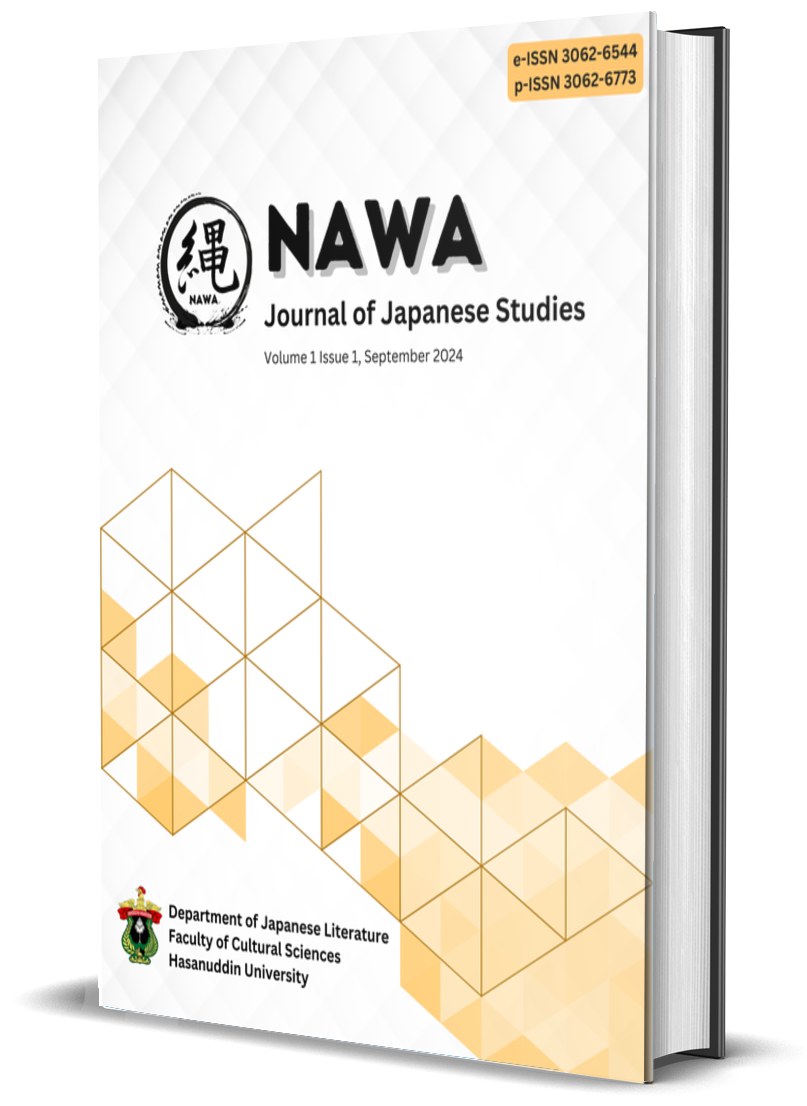Belajar Bahasa Jepang Melalui Manga
Fokus pada Pemerolehan Onomatope
DOI:
https://doi.org/10.69908/nawa.v1i1.36712Keywords:
vocabulary, onomatopoeia, mangaAbstract
Mastering vocabulary is crucial to learning foreign languages, which is also true for Japanese. One of the many ways to acquire Japanese vocabulary is through various media, such as manga. Manga is rich in onomatopoeias, a valuable tool for enhancing one's grasp of Japanese vocabulary. Onomatopoeias are imitations of sounds that help convey a particular state or condition, allowing the reader or listener to imagine and even "hear" the sound effect vividly. In his work, Ono (2007) defines onomatopoeia as words outside human speech tools, words that originate from human speech tools but cannot be parsed, and words that describe situations without a voice or audibility. This study explores how manga can bolster Japanese language skills, particularly in mastering onomatopoeia as a category of Japanese vocabulary. Employing qualitative methods, the study centred on the language phenomena found in manga. Data was gathered by systematically reading manga and identifying onomatopoeias, which were then analysed to comprehend their role in enriching Japanese vocabulary acquisition. The findings underscore how manga can enhance Japanese vocabulary, mainly through its use of onomatopoeia, with accompanying images making comprehension more accessible.
References
Adachi, M. (1997). Jinbe. Shogakukan.
Akita, K. & Pardeshi, P. (Eds.) .(2019). Ideophones, Mimetics and Expressives. Amsterdam/Philadelphia: John Benjamins. 10.1075/Ill.16
Aoyama. G. (2007). Meitantei Conan 59. Shogakukan.
Aoyama. G. (2018). Meitantei Conan 95. Shogakukan.
Dingemanse, M. (2019). ‘Ideophone' As A Comparative Concept’. In Akita, Kimi & Prashant Pardeshi (Eds.) (2019) 13-33.Https://Doi.Org/10.1075/Ill.16
Inoue, T. (1996). Slam Dunk 30. Shueisha.
Iwasaki, N., Sells, P., & Akita, K. (Eds.) (2016). The Grammar of Japanese Mimetics: Perspectives From Structure, Acquisition and Translation. Routledge.
Kindaichi, H. (1978). ‘Giongo Gitaigo Gaisetsu (A Survey of Onomatopoeia and Mimetic Words)’. In. Tsuruko Asano (Ed.) 1978.
Lopez, K. (2022). ‘A Study of EFL Vocabulary Learning with Online Application Quizlet’. KELT (37)
Miranda, S.A. C., Salazar, G.M.U., Larenas, C.H.D. (2018). ‘Comic-Based Instruction and Vocabulary Learning Among 11th and 12th Graders in Two Children Schools’. InterSedes, 39 (19) 78-103 DOI: 10.15517/Isucr.V19i39.34071
Mizuto, A. (2000). Milk Crown 1. Shogakukan.
Ono, E. (2018). Kocchi Muite! Miiko 31. Shogakukan.
Ono, M. (2007). Nihon Onomatope Jiten: Giongo-Gitaigo 4500. Shogakukan.
Peck, M. W. (2017). ‘Vocabulary Acquisition in the Foreign Language Classroom’. The Journal Of Nagasaki University of Foreign Studies (21)105-114. Http://Id.Nii.Ac.Jp/1165/00000584/
Yagami, H. (1996). Dear Boys 20. Kodansha.
Downloads
Published
How to Cite
Issue
Section
License
Copyright (c) 2024 Idrus Idrus

This work is licensed under a Creative Commons Attribution-ShareAlike 4.0 International License.







